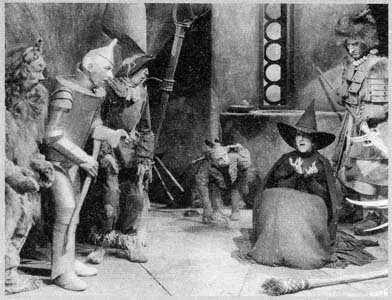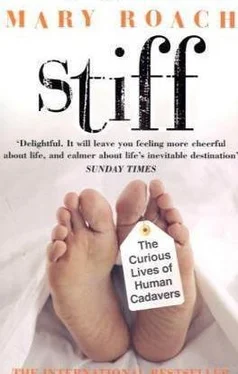3. LIFE AFTER DEATH
On Human Decay and What Can Be Done About It

Out behind the University of Tennessee Medical Center is a lovely, forested grove with squirrels leaping in the branches of hickory trees and birds calling and patches of green grass where people lie on their backs in the sun, or sometimes the shade, depending on where the researchers put them.
This pleasant Knoxville hillside is a field research facility, the only one in the world dedicated to the study of human decay. The people lying in the sun are dead. They are donated cadavers, helping, in their mute, fragrant way, to advance the science of criminal forensics. For the more you know about how dead bodies decay—the biological and chemical phases they go through, how long each phase lasts, how the environment affects these phases—the better equipped you are to figure out when any given body died: in other words, the day and even the approximate time of day it was murdered. The police are pretty good at pinpointing approximate time of death in recently dispatched bodies. The potassium level of the gel inside the eyes is helpful during the first twenty-four hours, as is algor mortis —the cooling of a dead body; barring temperature extremes, corpses lose about 1.5 degrees Fahrenheit per hour until they reach the temperature of the air around them. ( Rigor mortis is more variable: It starts a few hours after death, usually in the head and neck, and continues, moving on down the body, finishing up and disappearing anywhere from ten to forty-eight hours after death.)
If a body has been dead longer than three days, investigators turn to entomological clues (e.g., how old are these fly larvae?) and stages of decay for their answers. And decay is highly dependent on environmental and situational factors. What’s the weather been like? Was the body buried? In what? Seeking better understanding of the effects of these factors, the University of Tennessee (UT) Anthropological Research Facility, as it is blandly and vaguely called, has buried bodies in shallow graves, encased them in concrete, left them in car trunks and man-made ponds, and wrapped them in plastic bags. Pretty much anything a killer might do to dispose of a dead body the researchers at UT have done also.
To understand how these variables affect the time line of decomposition, you must be intimately acquainted with your control scenario: basic, unadulterated human decay. That’s why I’m here. That’s what I want to know: When you let nature take its course, just exactly what course does it take?
My guide to the world of human disassembly is a patient, amiable man named Arpad Vass. Vass has studied the science of human decomposition for more than a decade. He is an adjunct research professor of forensic anthropology at UT and a senior staff scientist at the nearby Oak Ridge National Laboratory. One of Arpad’s projects at ORNL has been to develop a method of pinpointing time of death by analyzing tissue samples from the victim’s organs and measuring the amounts of dozens of different time-dependent decay chemicals. This profile of decay chemicals is then matched against the typical profiles for that tissue for each passing postmortem hour. In test runs, Arpad’s method has determined the time of death to within plus or minus twelve hours.
The samples he used to establish the various chemical breakdown time lines came from bodies at the decay facility. Eighteen bodies, some seven hundred samples in all. It was an unspeakable task, particularly in the later stages of decomposition, and particularly for certain organs. “We’d have to roll the bodies over to get at the liver,” recalls Arpad. The brain he got to using a probe through the eye orbit. Interestingly, neither of these activities was responsible for Arpad’s closest brush with on-the-job regurgitation. “One day last summer,” he says weakly, “I inhaled a fly. I could feel it buzzing down my throat.”
I have asked Arpad what it’s like to do this sort of work. “What do you mean?” he asked me back. “You want a vivid description of what’s going through my brain as I’m cutting through a liver and all these larvae are spilling out all over me and juice pops out of the intestines?” I kind of did, but I kept quiet. He went on: “I don’t really focus on that. I try to focus on the value of the work. It takes the edge off the grotesqueness.”
As for the humanness of his specimens, that no longer disturbs him.
Though it once did. He used to lay the bodies on their stomachs so he didn’t have to see their faces.
This morning, Arpad and I are riding in the back of a van being driven by the lovable and agreeable Ron Walli, one of ORNL’s media relations guys. Ron pulls into a row of parking spaces at the far end of the UT Medical Center lot, labeled G section. On hot summer days, you can always find a parking space in G section, and not just because it’s a longer walk to the hospital. G section is bordered by a tall wooden fence topped with concertina wire, and on the other side of the fence are the bodies. Arpad steps down from the van. “Smell’s not that bad today,” he says. His “not that bad” has that hollow, over-upbeat tone one hears when spouses back over flowerbeds or home hair coloring goes awry.
Ron, who began the trip in a chipper mood, happily pointing out landmarks and singing along with the radio, has the look of a condemned man. Arpad sticks his head in the window. “Are you coming in, Ron, or are you going to hide in the car again?” Ron steps out and glumly follows. Although this is his fourth time in, he says he’l never get used to it. It’s not the fact that they’re dead—Ron saw accident victims routinely in his former post as a newspaper reporter—it’s the sights and smells of decay. “The smell just stays with you,” he says. “Or that’s what you imagine. I must have washed my hands and face twenty times after I got back from my first time out here.”
Just inside the gate are two old-fashioned metal mailboxes on posts, as though some of the residents had managed to convince the postal service that death, like rain or sleet or hail, should not stay the regular delivery of the U.S. Mail. Arpad opens one and pulls turquoise rubber surgical gloves from a box, two for him and two for me. He knows not to offer them to Ron.
“Let’s start over there.” Arpad is pointing to a large male figure about twenty feet distant. From this distance, he could be napping, though there is something in the lay of the arms and the stillness of him that suggests something more permanent. We walk toward the man. Ron stays near the gate, feigning interest in the construction details of a toolshed.
Like many big-bellied people in Tennessee, the dead man is dressed for comfort. He wears gray sweatpants and a single-pocket white T-shirt.
Arpad explains that one of the graduate students is studying the effects of clothing on the decay process. Normally, they are naked.
The cadaver in the sweatpants is the newest arrival. He will be our poster man for the first stage of human decay, the “fresh” stage. (“Fresh,” as in fresh fish, not fresh air. As in recently dead but not necessarily something you want to put your nose right up to.) The hallmark of fresh-stage decay is a process called autolysis, or self-digestion. Human cells use enzymes to cleave molecules, breaking compounds down into things they can use.
While a person is alive, the cells keep these enzymes in check, preventing them from breaking down the cells’ own walls. After death, the enzymes operate unchecked and begin eating through the cell structure, allowing the liquid inside to leak out.
Читать дальше













